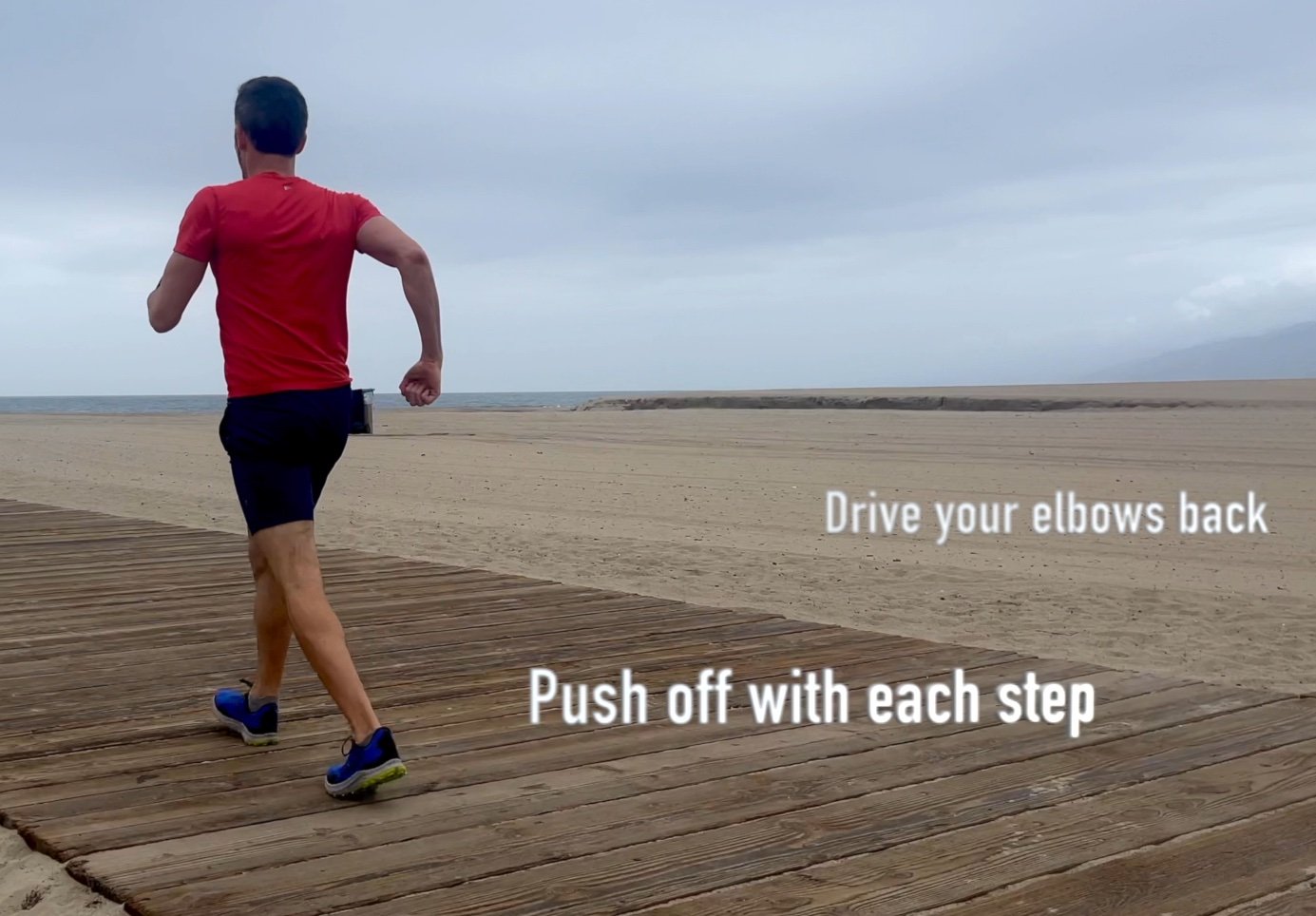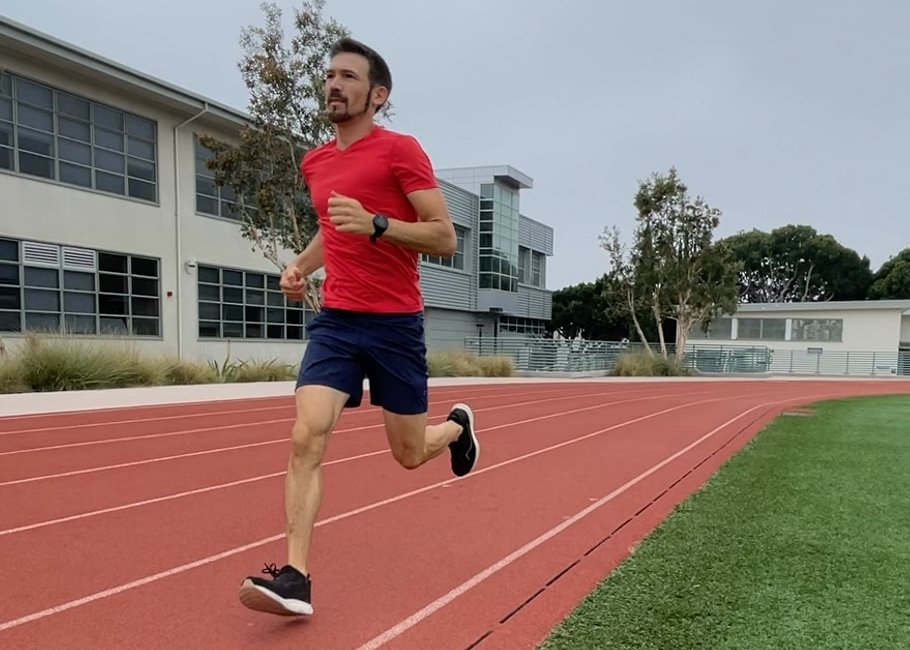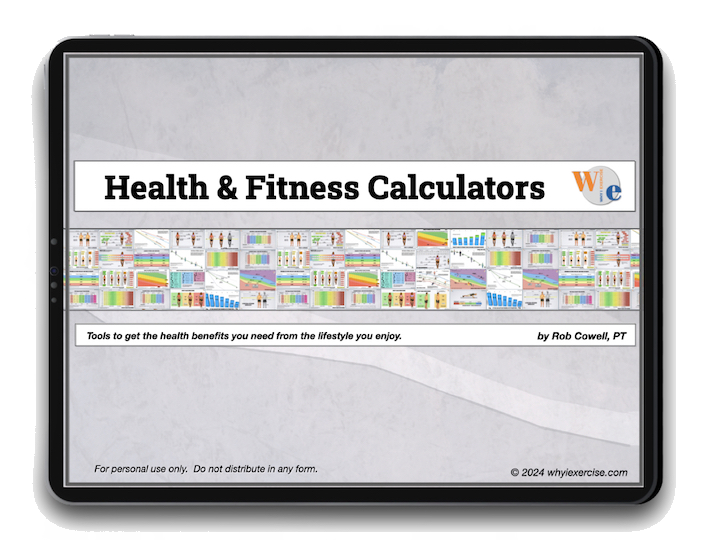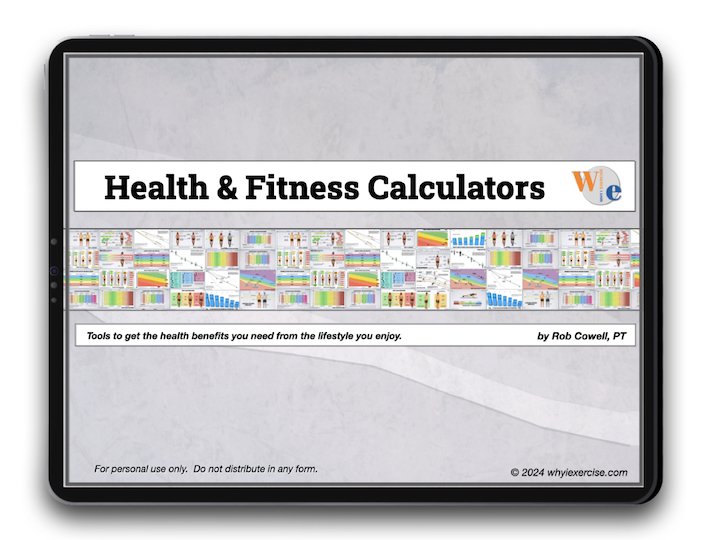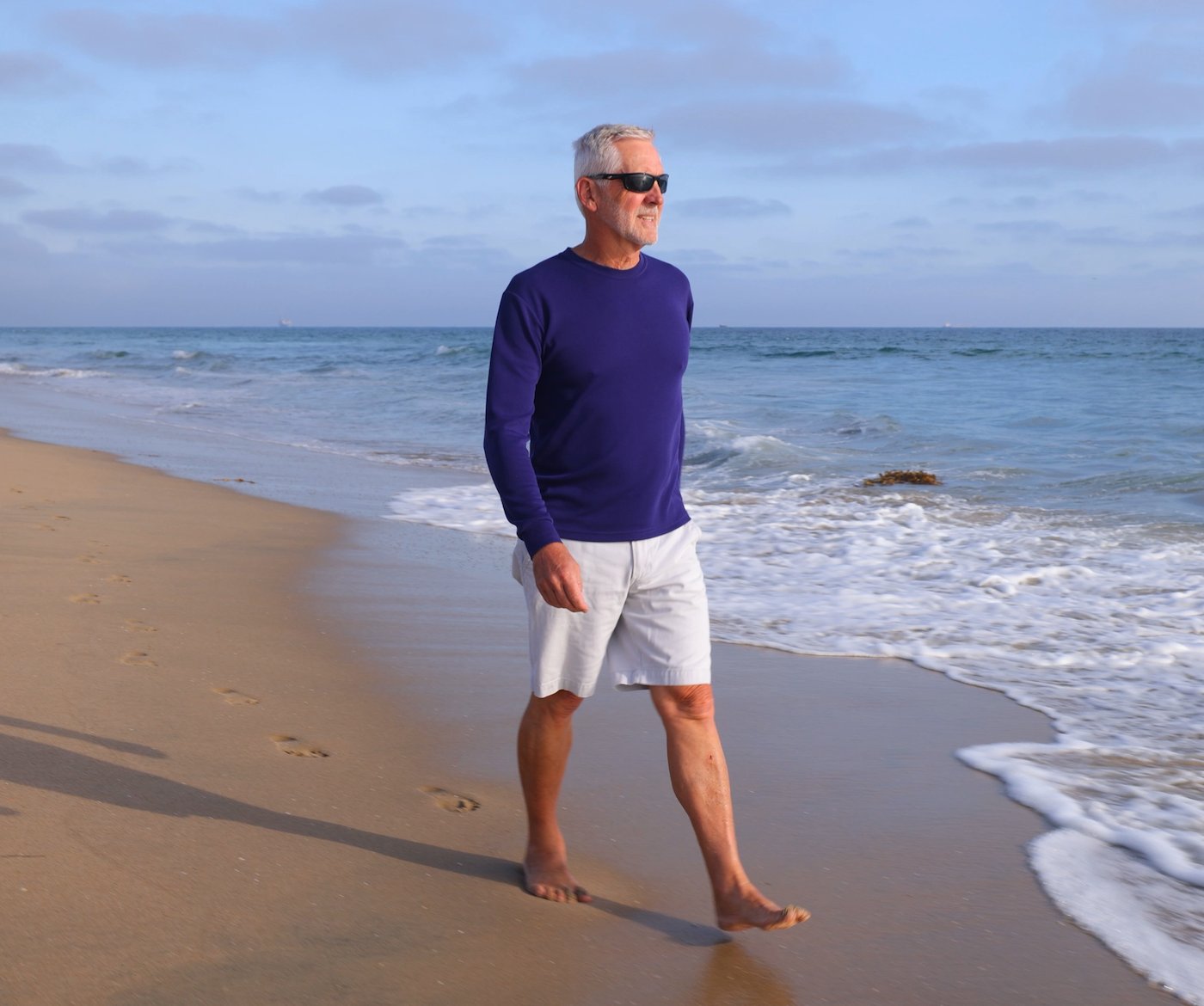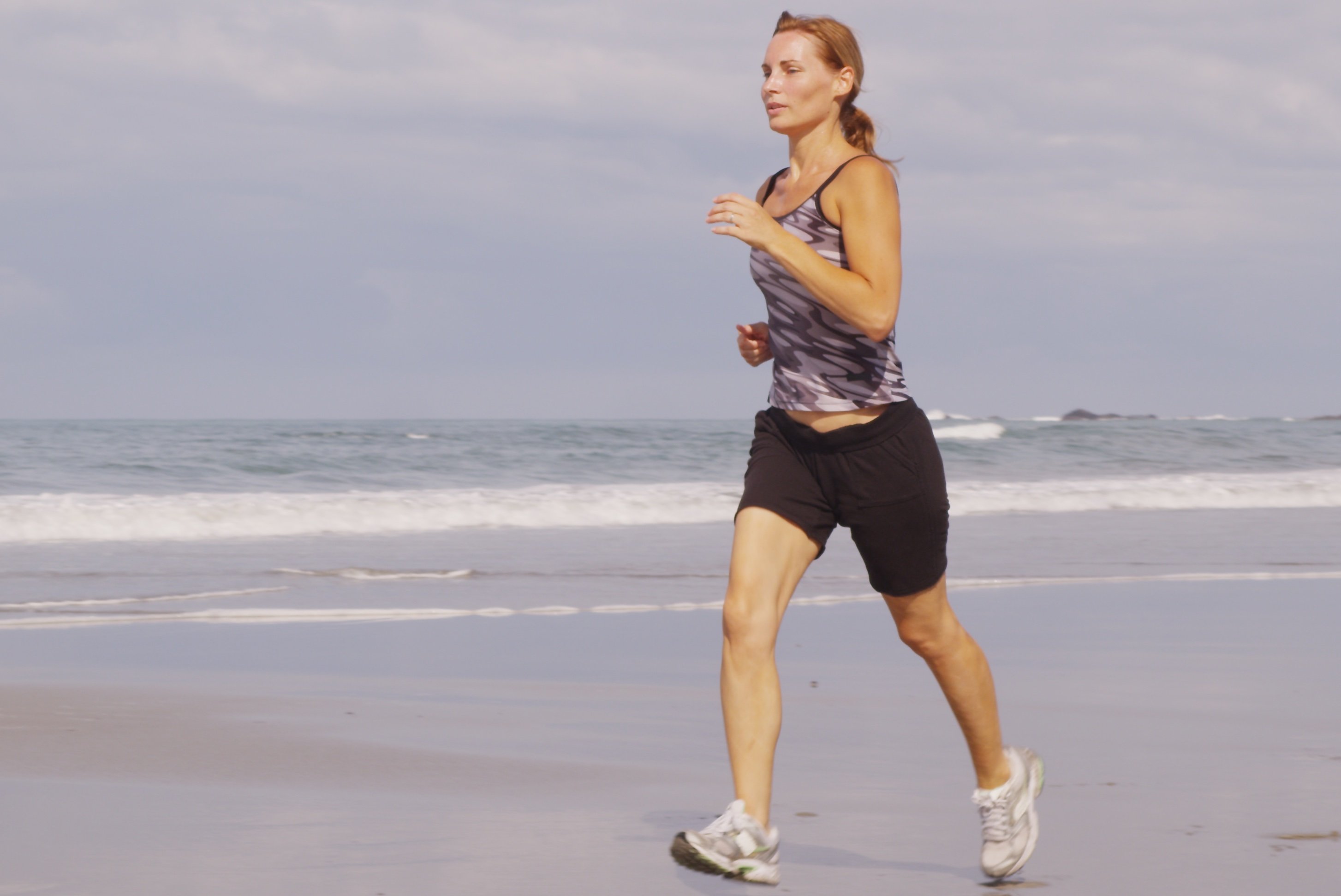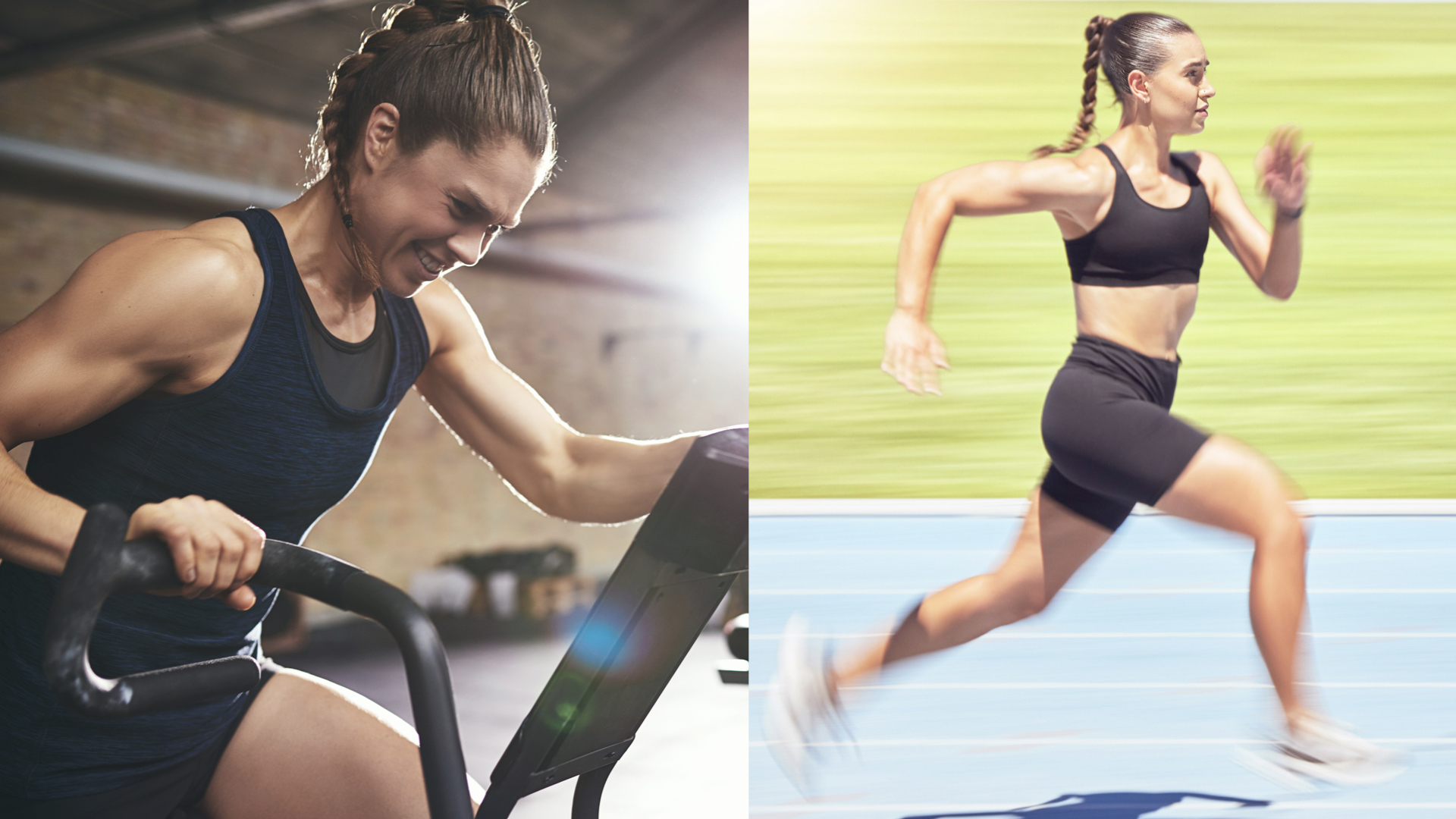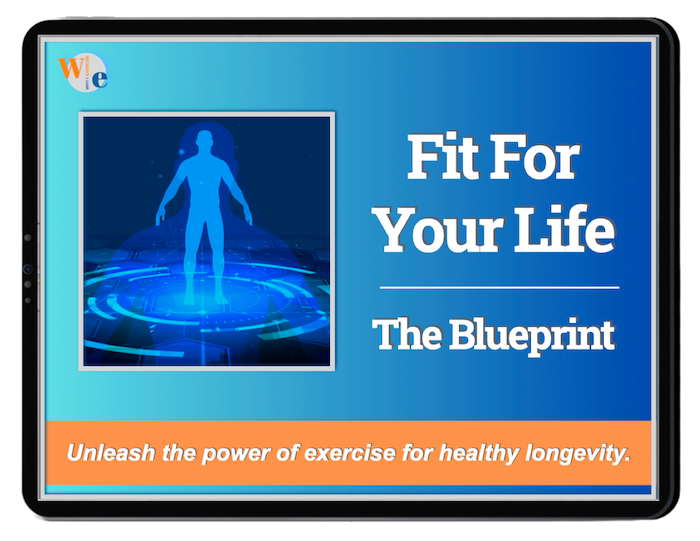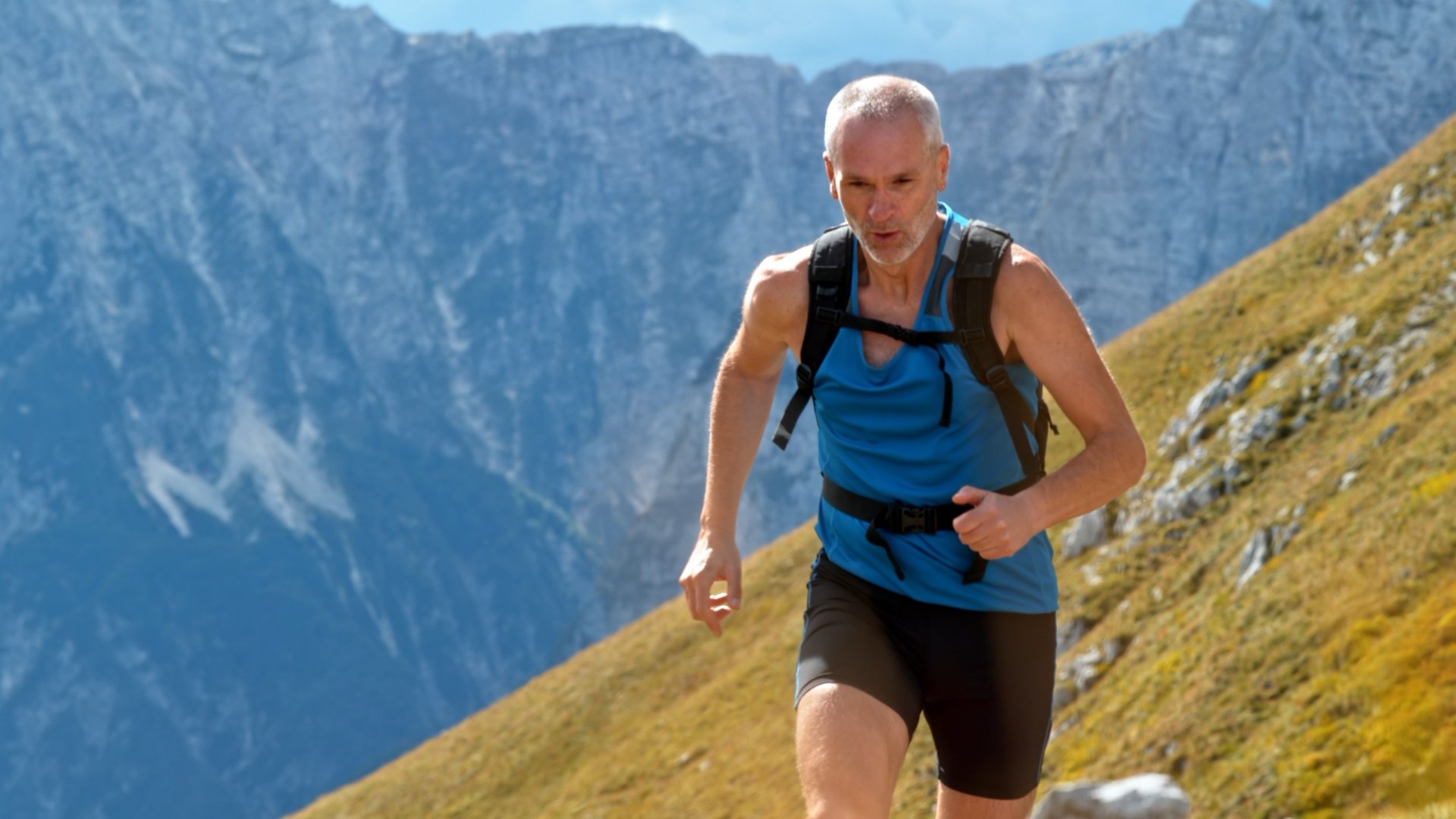
VO2 Max
A leading health indicator that you can test for yourself!
What is VO2 Max?
VO2 max is the maximum amount of oxygen a person can utilize during exercise, and it’s an excellent indicator of cardiovascular fitness and overall well-being. The higher your VO2 max, the easier it is to tolerate long, intense exercise sessions.
This health measurement is scored based on milliliters of oxygen used per kilogram per minute (ml O2 / kg/min).
 A strong VO2 max is known to enhance athletic performance. More importantly, it also has a wide-ranging effect on our health.
A strong VO2 max is known to enhance athletic performance. More importantly, it also has a wide-ranging effect on our health.A strong VO2 max is known to enhance athletic performance. More importantly, it also has a wide-ranging effect on our health.
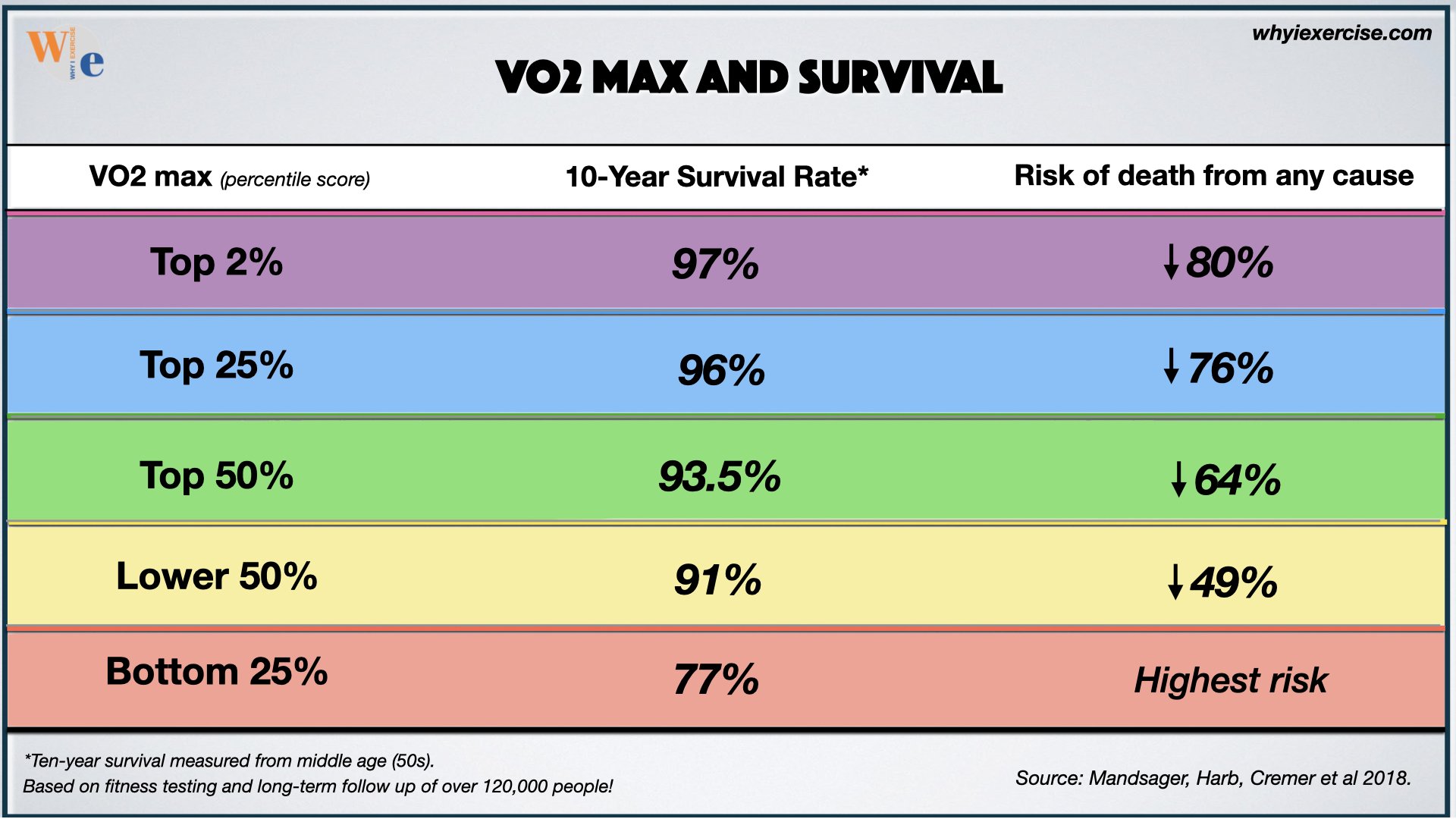 A modest improvement in fitness can improve 10-year survival rate (in middle age) substantially.
A modest improvement in fitness can improve 10-year survival rate (in middle age) substantially.People with higher VO2 max values have lower risks of premature death, cardiovascular disease, and chronic conditions like type 2 diabetes (1-4). A recent 122,000-person study showed that fit and athletic people in their 50s have a 96% or higher 10-year survival rate.
How does this compare to people who are out of shape?
The Cleveland Clinic found that 10-year survival for people in their 50s with poor fitness is a shockingly low 77% (5). Continue reading to see the cardio fitness scoring standards for your age group and how to test yourself accurately!
*A 2022 study on cardio fitness in US Veterans had similar results to the Cleveland Clinic. Study participants with the lowest fitness level had four times the mortality risk of extremely fit subjects. As with the Cleveland Clinic study, extremely fit subjects had the lowest risk of death compared to all other fitness levels (20).
How to Self-test your VO2 max!
VO2 max lab tests directly measure your body’s ability to take in oxygen, push it through the bloodstream to your muscles, and use it as energy for exercise.
Lab testing offers the most precise scores, but the self-tests below are free and less time-consuming. They are excellent estimates.
Studies have found a strong correlation between VO2 max lab tests, the Cooper Test, and the Rockport Walking Test (6-8). You can use these self-tests to reliably gauge your progress as you work to improve your fitness.
See demos of the fitness tests in this highly recommended YouTube video from Why I Exercise.
Age Group Charts, Based on Rate of Survival
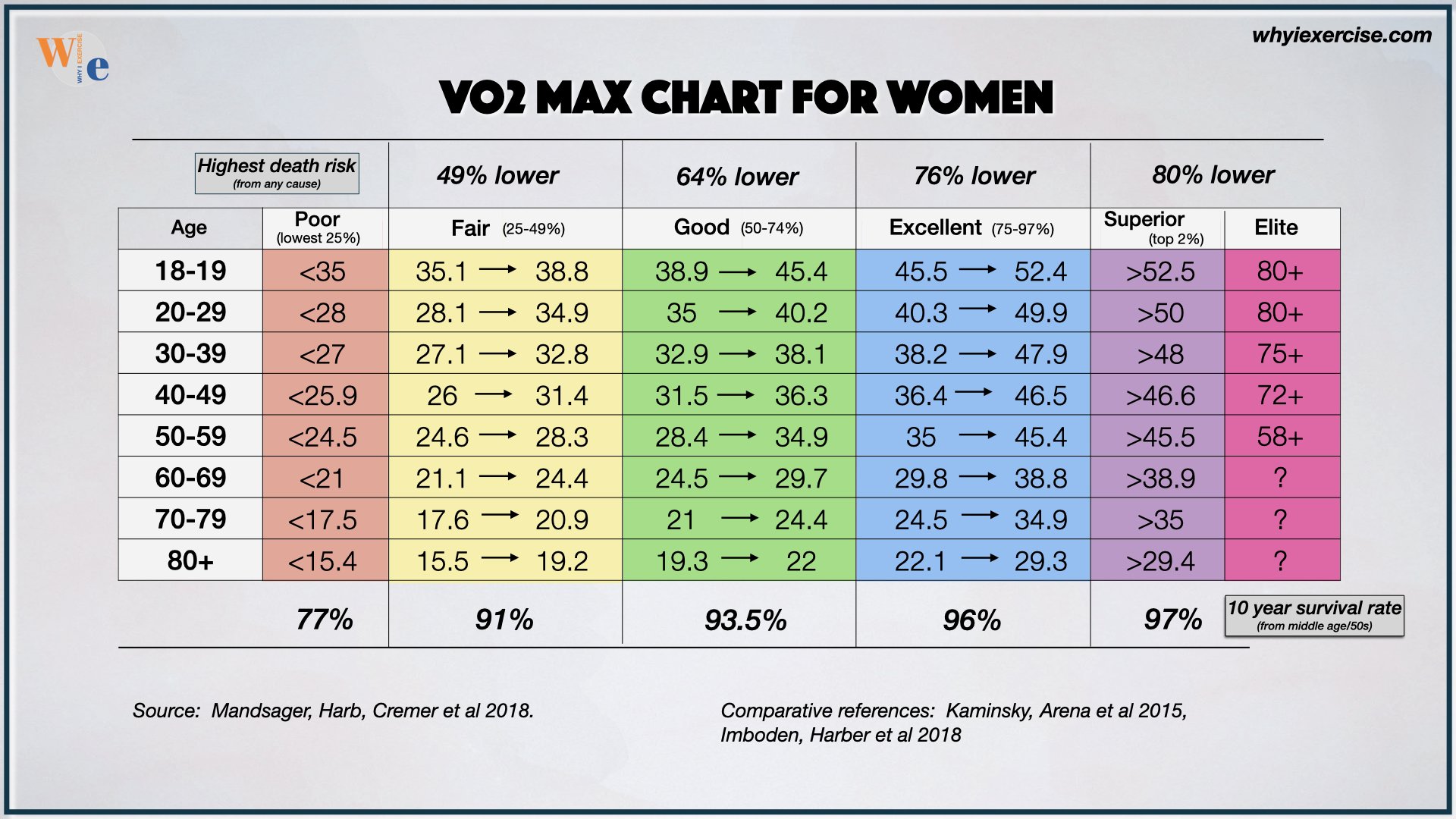
These charts show VO2 max scoring standards by age group and survival rate. Death risk is the top row, and 10-year-survival is in the bottom row.
According to the most current reference data, about 40% of US adults have tested as high risk and out-of-shape, and less than 20% were in the fit and low-risk category by the Cleveland Clinic standards (5,9).
Cardio fitness matters for everyday life too. A 55-year-old woman with poor fitness has a score below 25. In her case, walking briskly (4 mph) would feel like strenuous exercise. A brisk walk with inclines would be out of reach at her level (10).
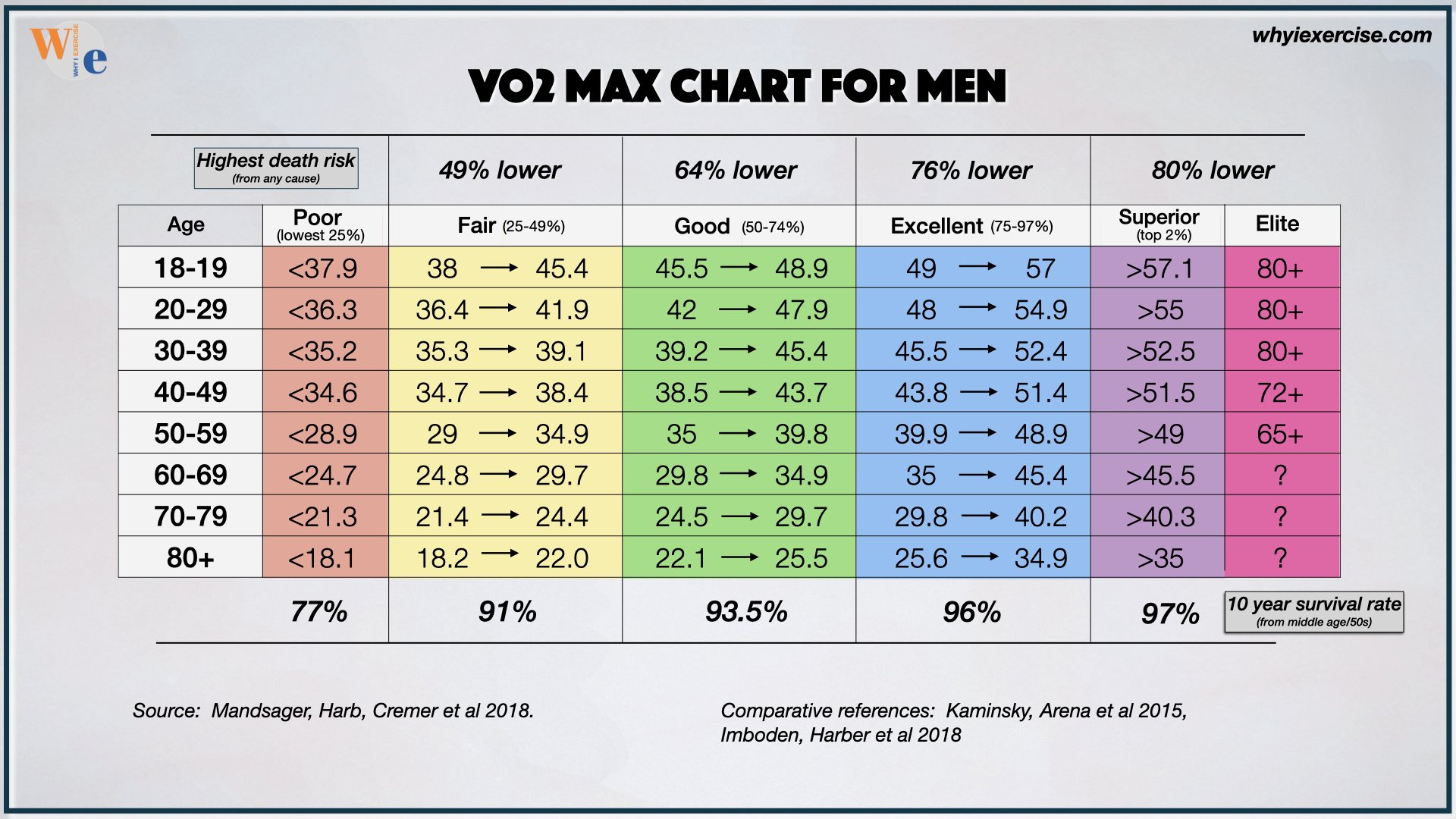
An out-of-shape 35-year-old man has a VO2 max of 35 or less, which means activities like court sports or backpacking may be exhausting for him.
Where do you think you’ll score? If you haven’t been exercising much or have trouble jogging, the best starting point is the Rockport Walking Test.
Vo2 max test #1: The Rockport walking test
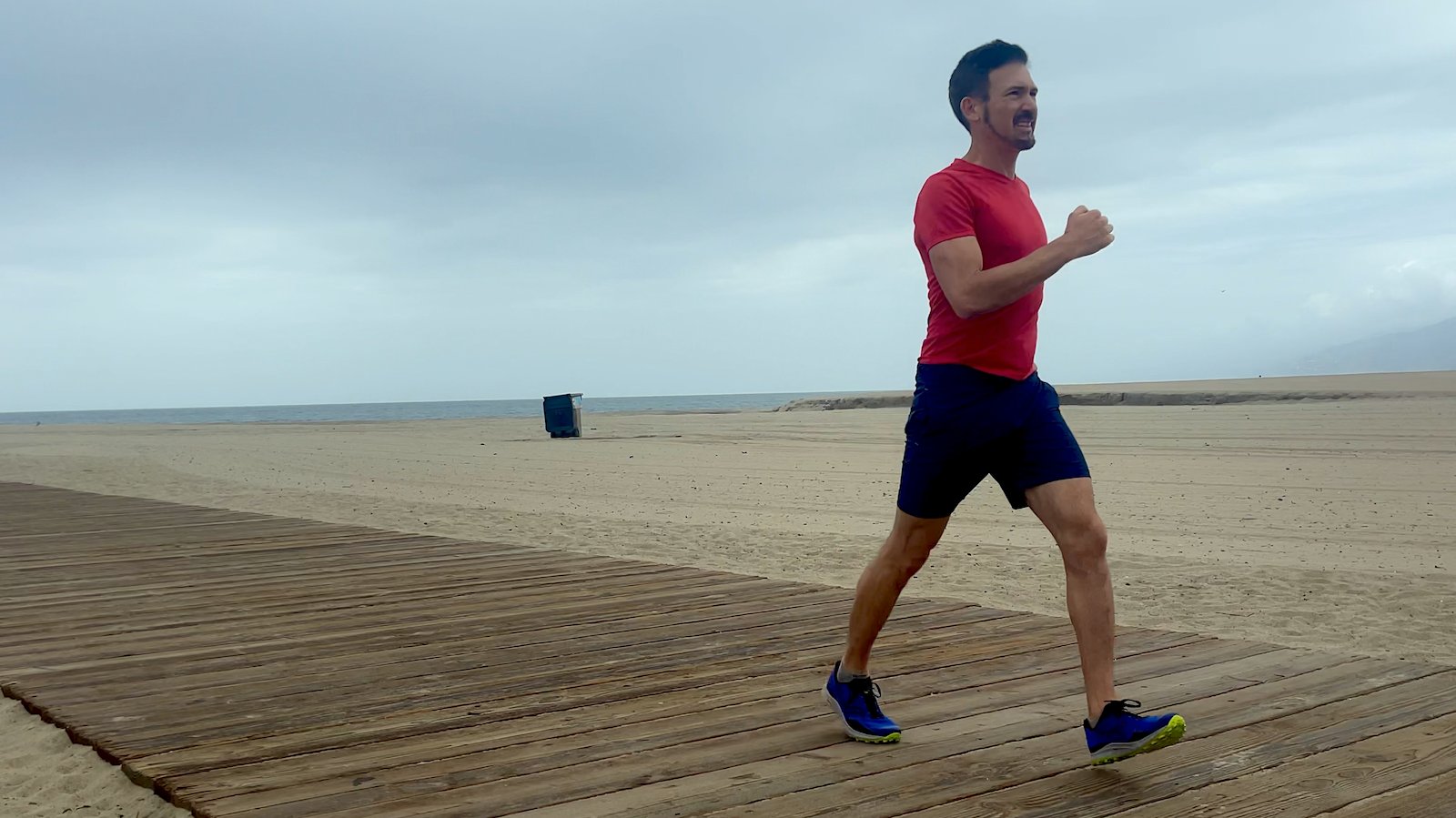 The Rockport Test is the perfect cardio fitness test for beginners.
The Rockport Test is the perfect cardio fitness test for beginners.The Rockport Walking Test is the best entry-level, low-impact test for estimating your VO2 max. It's a timed one-mile brisk walk on a flat surface (6). Walk at your best pace, then take your pulse by hand for 15 seconds.
Enter your heart rate and the time to walk a mile into the calculator. The charts show the standards for women and men by age group. Notice the difference it makes to improve from poor to fair on the charts below!
Calculate your VO2 max & other fitness metrics.
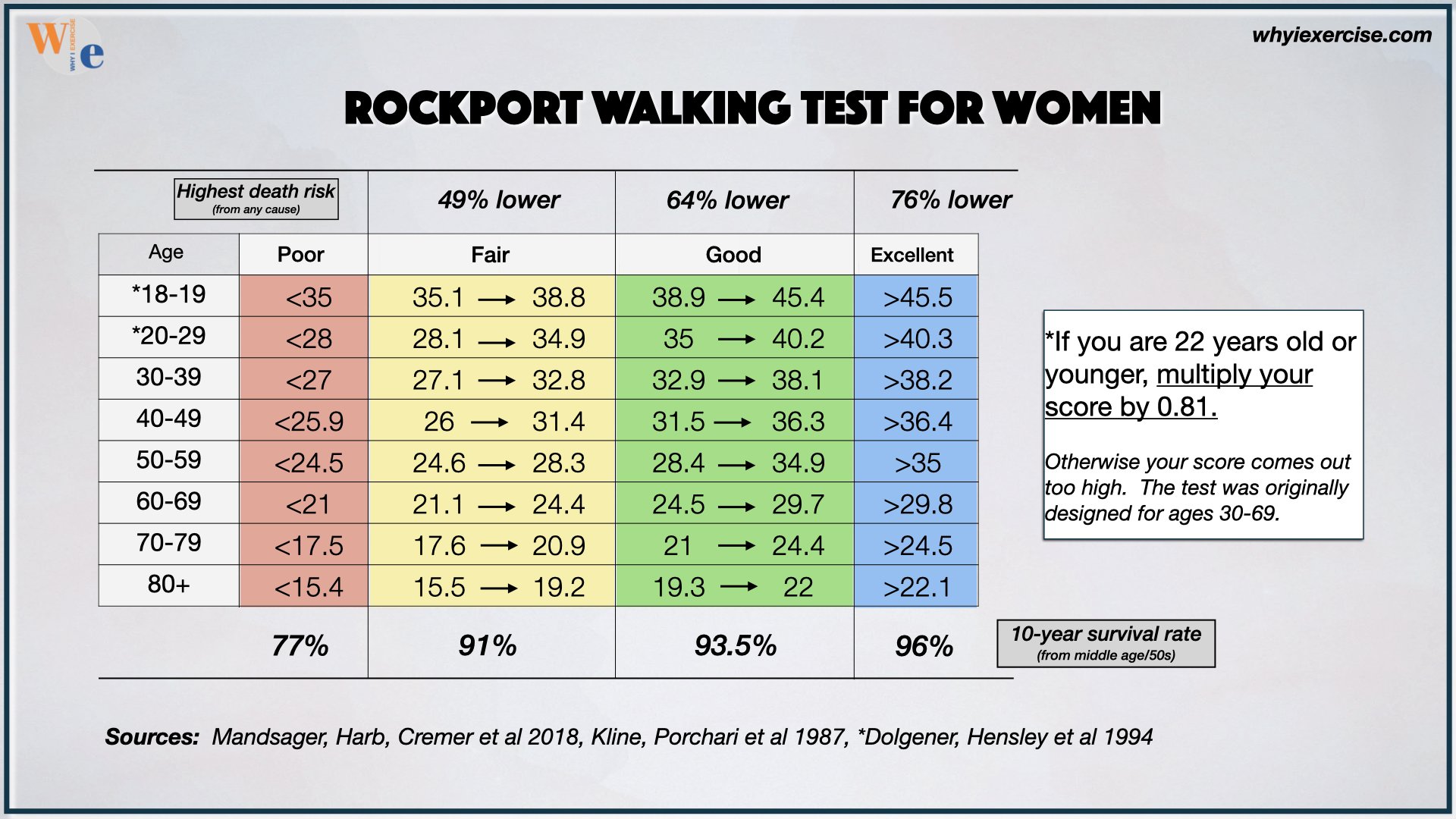 Your score from the calculator is a direct estimate of your VO2 max.
Your score from the calculator is a direct estimate of your VO2 max.If you are a woman 22 years old or younger, multiply the number you get from the calculator by 0.81 to get your score. Age group is in the left column, death risk and fitness rating are in the top rows, and 10-year-survival is in the bottom row.
If you’re a man, 22 or younger, multiply the number you get from the calculator by 0.85 to get your score (6). These scoring standards reflect current and robust research on Vo2 max.
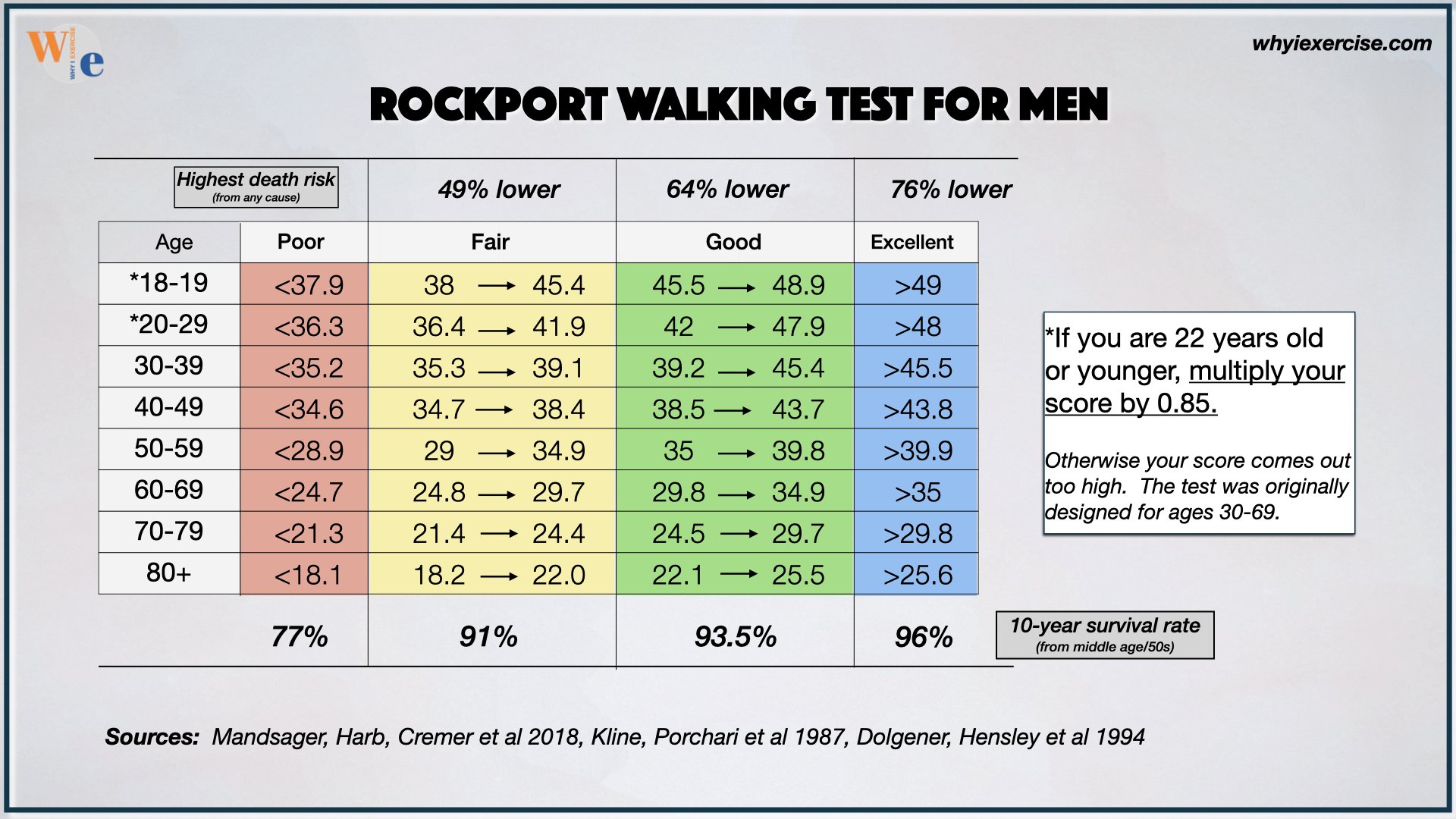
The Rockport Test gives the most reliable results for non-athlete working-age adults, and the test is excellent when performed correctly. Getting your best, most accurate score depends on your walking speed and level of exertion, which affects your heart rate.
If you can jog or run and your health care provider has cleared you for exercise testing, a maximum effort test will give you a more accurate score. In this case, you have two top options for your VO2 max test: the Cooper 12-Minute Run and the Cooper 1.5-Mile Run.
Hold a constant strong effort, and either test will give you a close representation of your VO2 Max score (8).
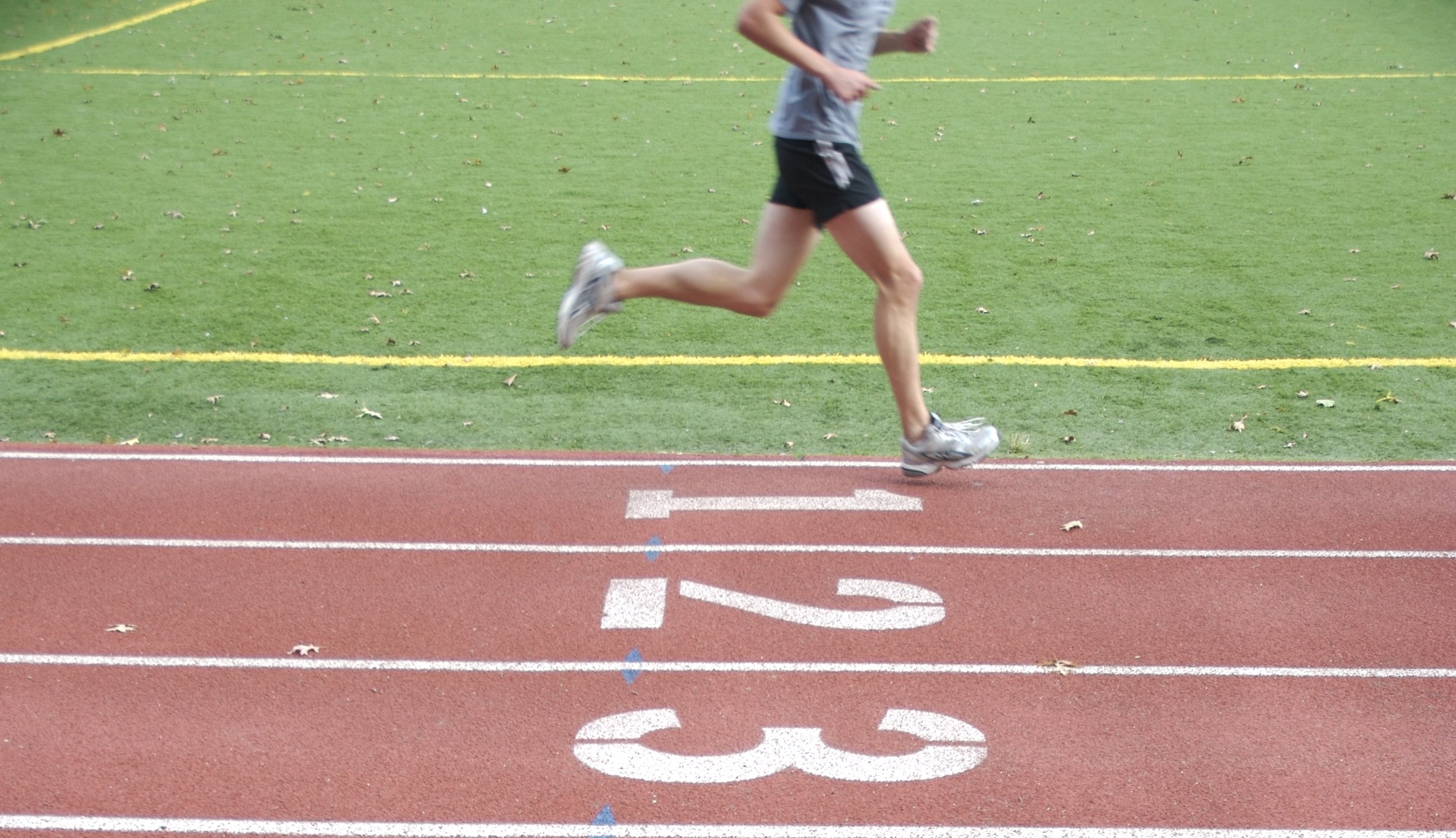 Try the Cooper test instead if you're athletic and able to run.
Try the Cooper test instead if you're athletic and able to run.VO2 max test #2: The Cooper 12-Minute Run
To measure the distance you cover in 12 minutes, you’ll need to use a fitness watch, treadmill, or track (with a stopwatch). Treadmills make running easier, so to simulate outdoor running, set the treadmill at a 1% grade.
Prepare your heart, lungs, and muscles for this maximum effort test with a 10-minute warm-up of exercises, brisk walking or jogging, and brief stretches.
Start at a pace you can maintain throughout the test to get your best score. Your watch or treadmill will show the distance you cover in 12 minutes, which is your score.
When you finish the test, you’ll know where you stand and how much you might need to improve for a better survival rate.
The test scores are organized like the charts above to give you a health risk rating for your score. Our free fitness calculator gives you your VO2 max score directly from your test result, plus other key health metrics.
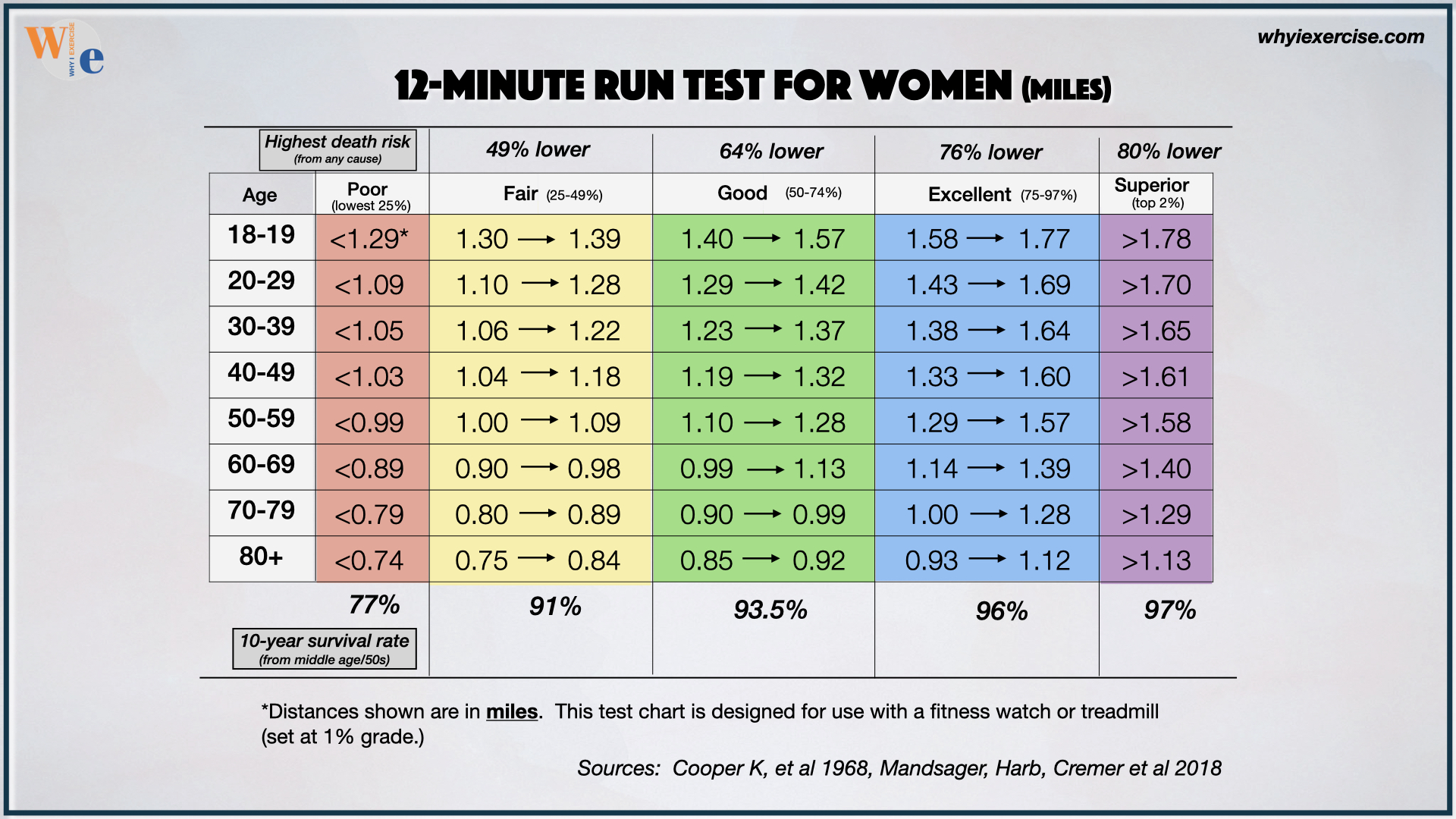 12-minute run chart scores by age group, scored in miles.
12-minute run chart scores by age group, scored in miles.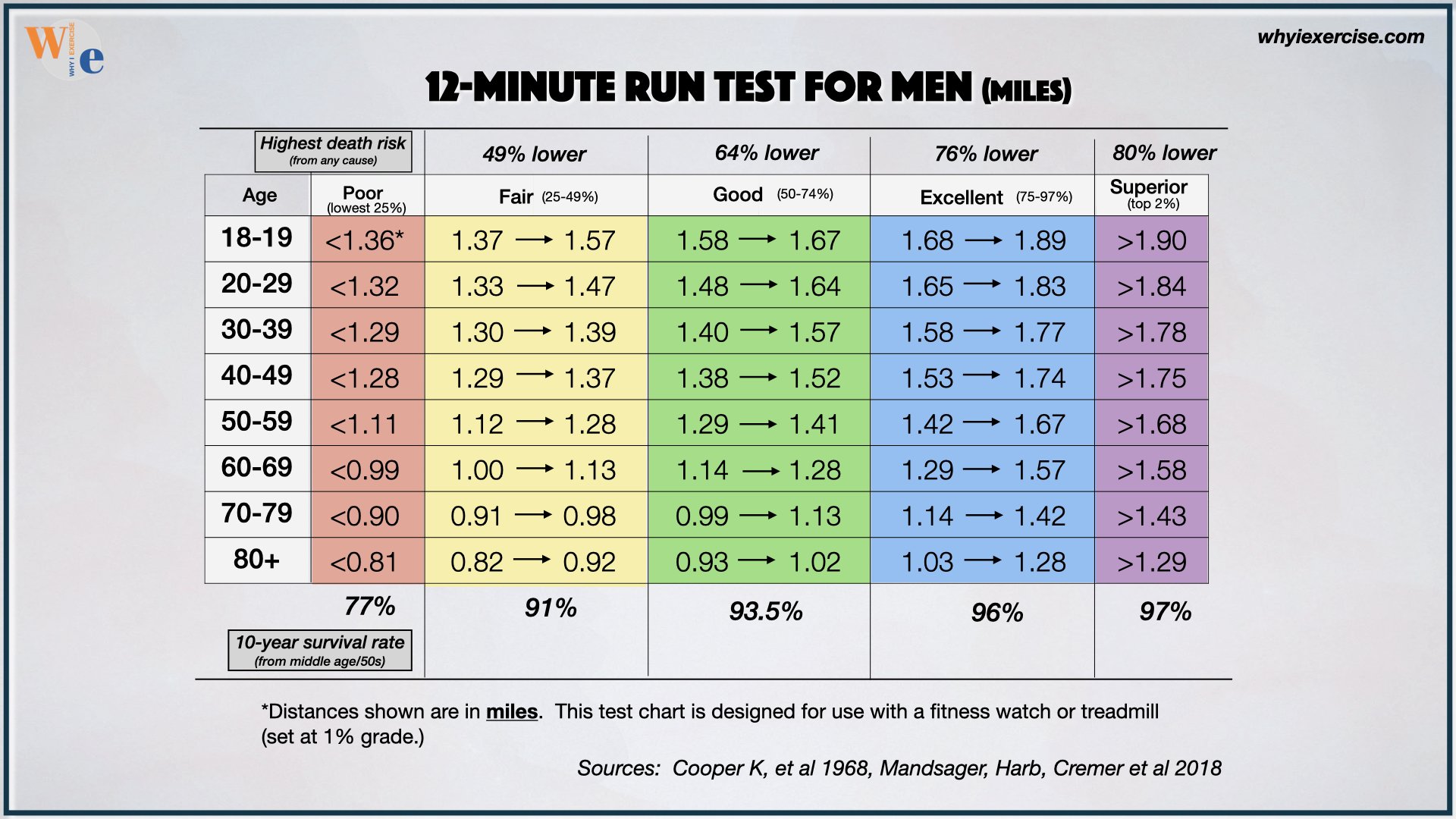 Men's age-group standards for the 12-minute run (in miles).
Men's age-group standards for the 12-minute run (in miles).Often, we only need modest improvements in our fitness to make a meaningful difference in our long-term health.
Suppose you are a 35-year-old female who ran 1.15 miles in 12 minutes. Your fitness rating would be associated with a 10-year survival rate of 91% and a 49% lower risk of death than your peers with poor fitness.
If you were to train for 6-12 weeks and improve your distance by less than one-tenth of a mile, you would meet the standards to improve your survival rate to 93.5%, and your death risk level would improve to 64% lower than peers with poor fitness.
VO2 max test #3: The Cooper 1.5-Mile Run
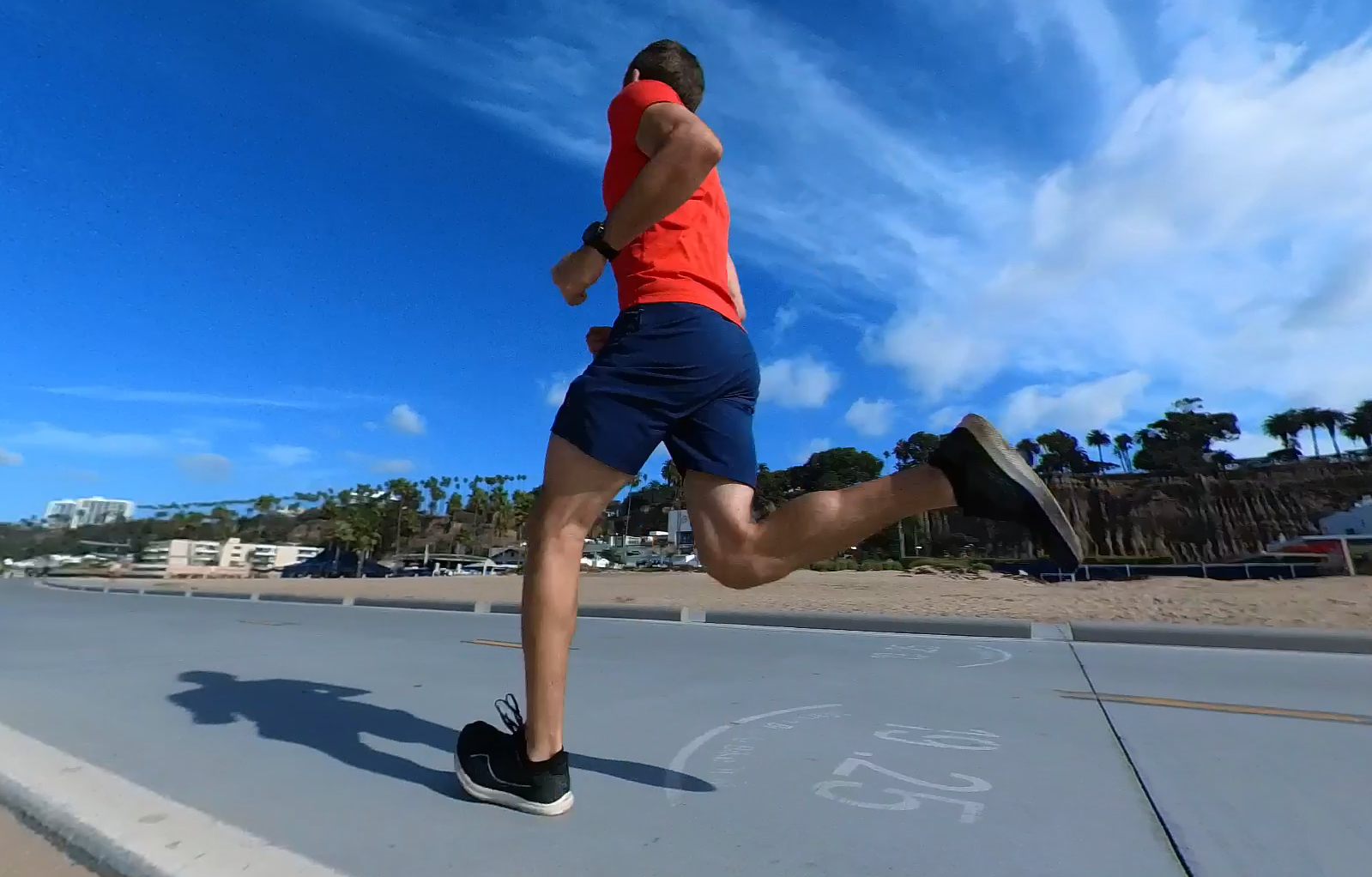 Try not to start too quickly. Your best result comes by keeping an even pace throughout the run
Try not to start too quickly. Your best result comes by keeping an even pace throughout the runFor the 1.5-mile run, you need a timer or stopwatch, a flat, measured distance of 1.5 miles for your run, and your best effort. Warm up to prepare your muscles, heart, and lungs for a top effort.
Our Cooper Test article shows you how to get the most from your best effort, avoiding the most common pacing errors. When you give your best effort, this is an excellent representation of your cardio fitness, proven to correlate closely with VO2 max lab testing.
One of the best advantages of the 1.5-mile run is that you can see exactly how much faster you need to go to reach your goal if your score is sub-par. Test again to check your progress after a few months of training.
Your score in minutes & seconds is rated by health risk as in the previous charts. Cooper test results are close enough to lab testing to be used as reliable training targets to aim for optimal health and athletic performance.
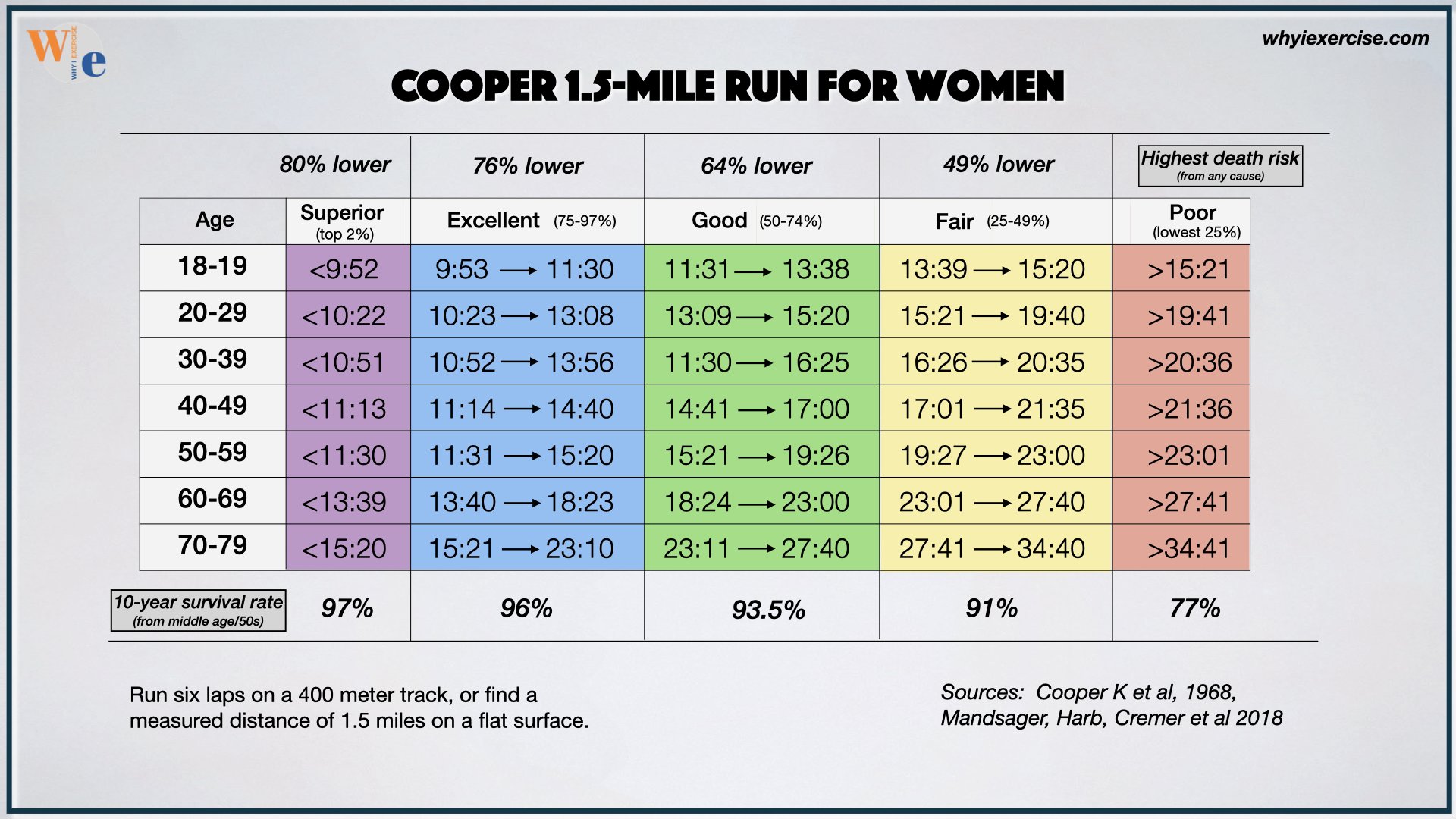 Age-group women's standards for the Cooper 1.5 mile run according to current VO2 max research.
Age-group women's standards for the Cooper 1.5 mile run according to current VO2 max research.Scroll down to calculate your VO2 max directly from your 1.5-mile run.
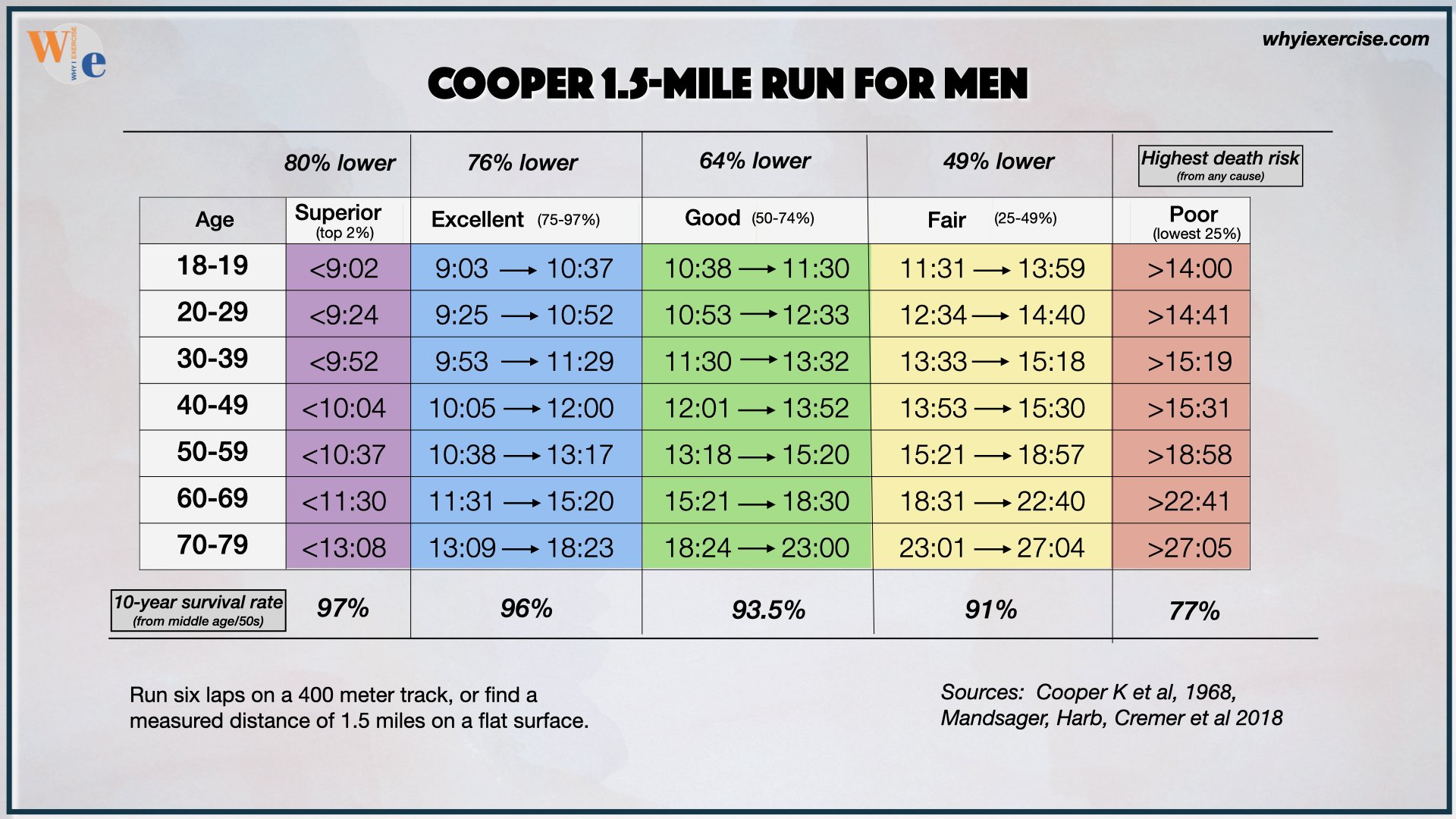 Men's age-group standards for the Cooper 1.5-mile run.
Men's age-group standards for the Cooper 1.5-mile run.If you already run regularly, now you know the fitness level you need to maintain for optimal health benefits, as per current research.
As with the 12-minute run, modest improvements in your 1.5-mile run time can make a difference in your health risk.
Do you meet the healthy standard for VO2 max?
VO2 Max For Seniors, With A Six-Minute Walk
If you or a family member have trouble walking continuously for a mile, you could start by working toward a walking speed of 3 mph for six minutes.
Three mph for 6 minutes is equivalent to a VO2 max of 16.5, according to a 2010 Baylor Study (13). A 2009 Canadian study found that women and men whose VO2 max fell below this range were likely to depend on others for their daily needs(10).
If you can walk 3.5 mph for 6 minutes, that gives you a score of 18.7 (13).
Our walking speed article allows you to compare your score to age-group, health and independence standards for seniors. You'll also learn a balance and strengthening routine designed by a physical therapist to improve your walking speed.
Training to improve your VO2 Max
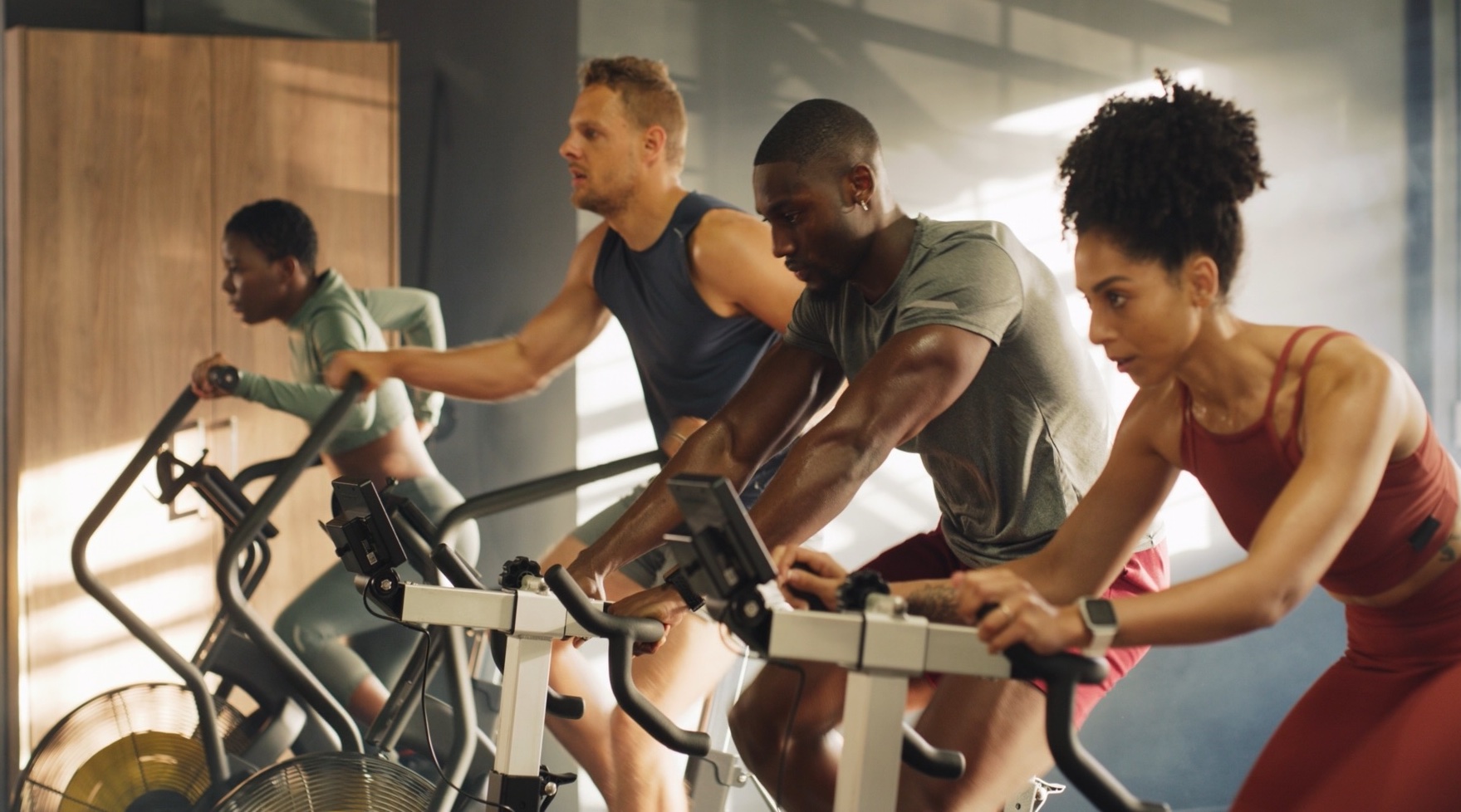 Nearly everyone benefits from improving their fitness, and people with poor fitness benefit the most.
Nearly everyone benefits from improving their fitness, and people with poor fitness benefit the most.Improving your cardio fitness may be the most efficient way to improve your overall health. A review of 33 studies found that improving your cardio fitness by just 3.5 points will lower your risk of premature death from any cause by 13% (12).
A 2013 study found that training programs with vigorous workouts and high-intensity interval training allowed participants to increase their VO2 max by 5 points or more within 6-13 weeks (18). If you're not used to vigorous exercise, use moderate-intensity endurance training at first.
Another study found that about 80% of the above results could be achieved with 20 weeks of training starting at moderate intensity, slowly building over the weeks to vigorous exercise (19). The 2013 study found that three to five-minute intervals and continuous vigorous exercise offer the fastest increases in cardio fitness.
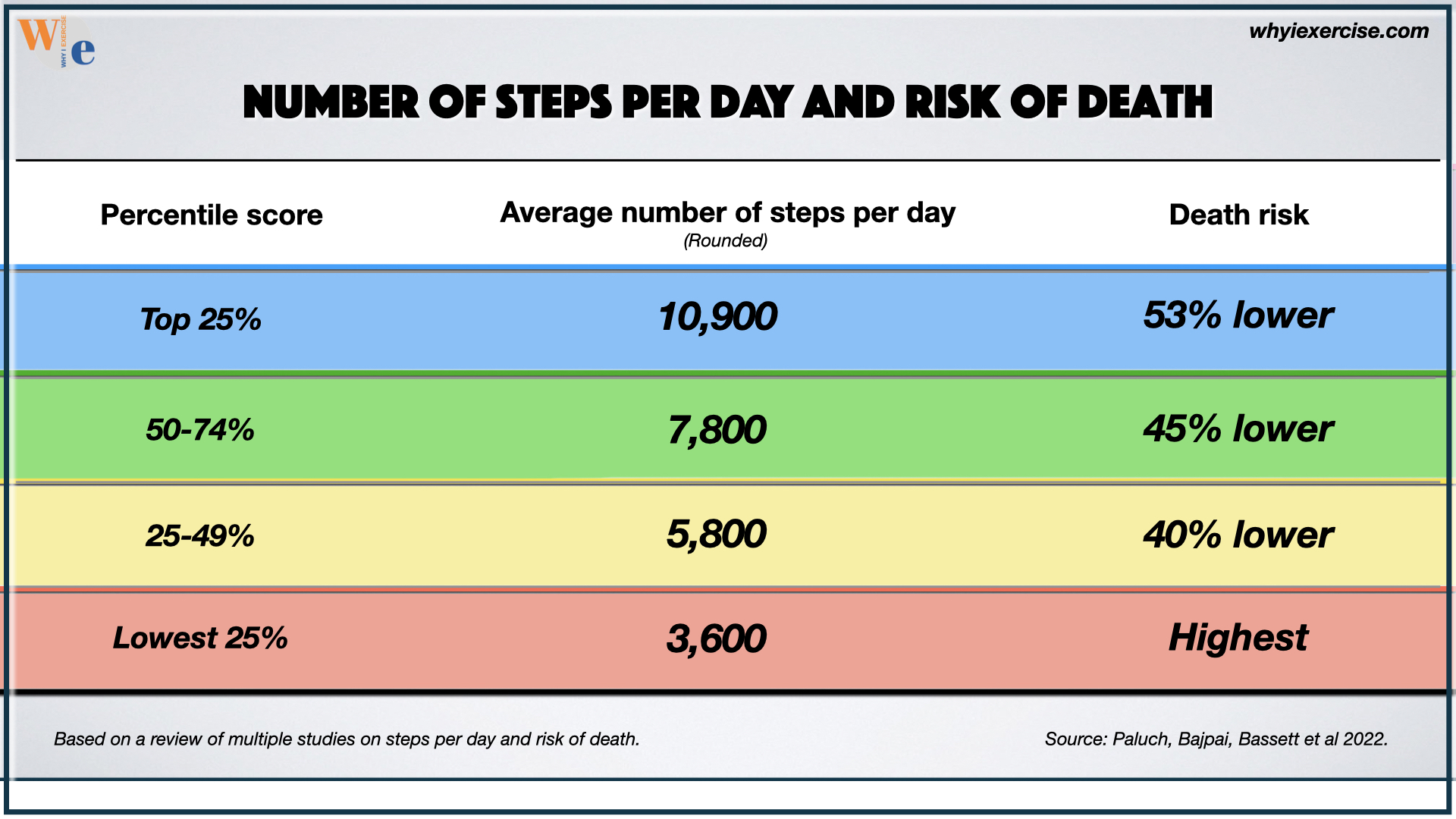 If you don't exercise, add a 20-minute walk to your daily routine. This meets the standard for a 40% lower risk of death.
If you don't exercise, add a 20-minute walk to your daily routine. This meets the standard for a 40% lower risk of death.People who don’t exercise happen to be the ones who would benefit the most from becoming more active, and a review of step-counting studies uncovered what may be a perfect starting point to get back in shape.
According to the review, people who don’t exercise take an average of about 3600 steps per day. It only takes a total of 5800 steps, an extra 20-minute walk per day, for a sedentary person to join the group with a 40% lower risk of death (15).
The Cleveland Clinic study showed that nearly everyone benefits from improving their conditioning, even people with excellent fitness. The survival data from their study comes from VO2 Max testing plus 15 years of follow-up with over 120,000 people (5). An improved VO2 max score also protects brain health by lowering risks of dementia and cognitive decline (16-17).
What causes low cardio fitness (VO2 max)?
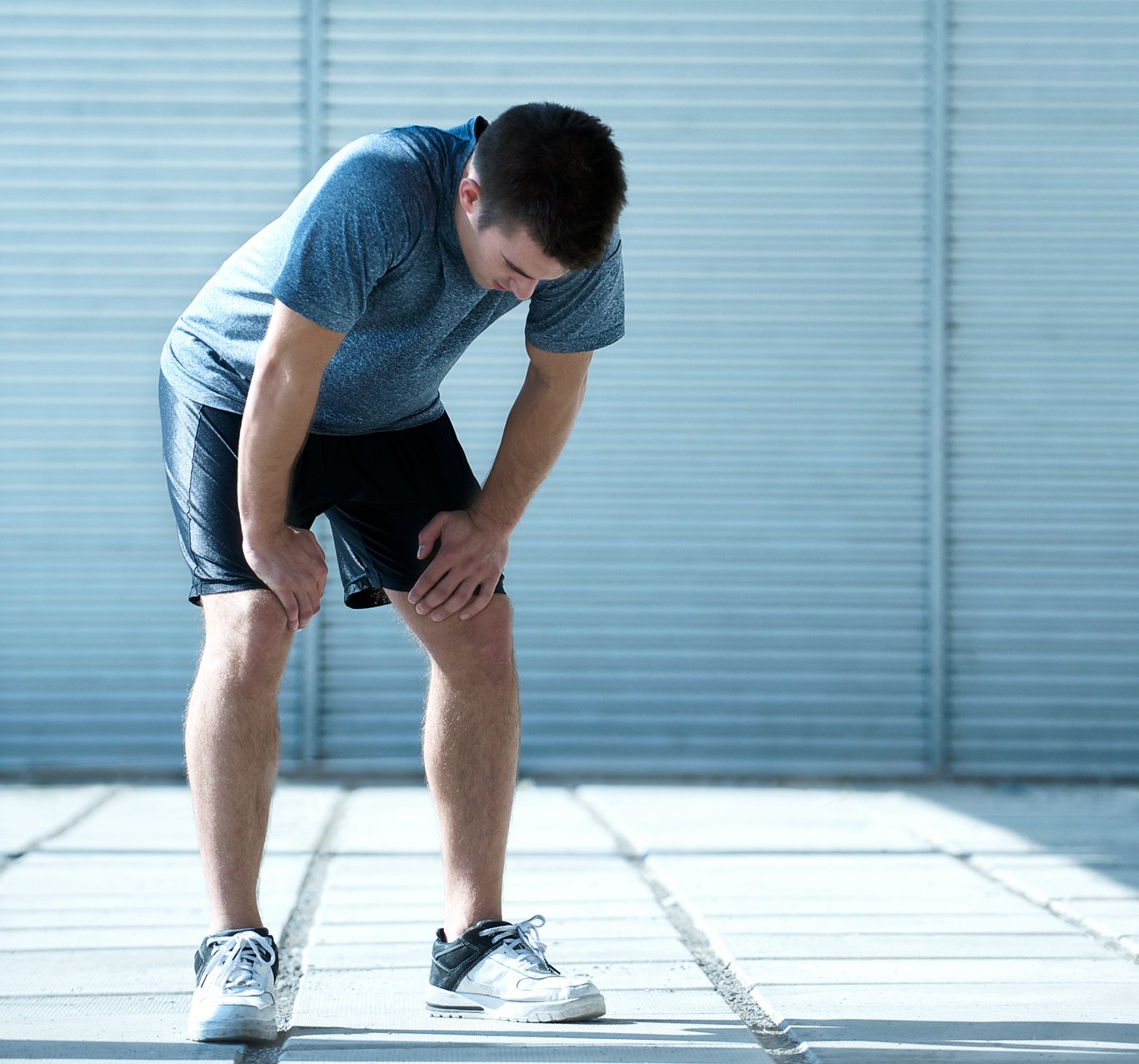
Low cardio fitness is a VO2 max score in the lowest 25% compared to your age and gender peers. If you're having trouble improving your cardio fitness or you don’t feel naturally inclined toward endurance exercise, any of the six factors* below may be affecting your struggle with cardio conditioning
1. Body mass index (BMI) and waist circumference— studies show that VO2 max trends higher for those with a lower body mass index and a smaller waist circumference. Compare your measurements to healthy standards.
2. Aging— On average, VO2 max tends to decline slowly in young adulthood, increasing to 10% per decade in middle age and about 15% per decade through the retirement years. Learn more about aging and exercise.
3. Nutrition— 58% of calories consumed in the US are from ultra-processed foods, and a review of studies found that high adherence to the Mediterranean Diet is associated with improved cardiovascular and overall physical fitness.
4. Stress—Over 70% of adults experience negative impacts of stress on their eating habits, interests in hobbies or activities, or physical health, all of which can interfere with exercise training.
5. Sleep quality— lack of sleep can worsen your results from training by limiting recovery after exercise and increasing the risk of injury from exercising.
6. Genetics —50% of the difference in baseline VO2 max from person to person can be due to genetics. Improved fitness after cardio training can also vary by 50%.
*Learn more about these six factors on low VO2 max, and get the references.
Conclusion
VO2 max is such a strong health indicator that the American Heart Association considers it a clinical vital sign. For many people, a minor boost in their fitness can make a meaningful difference in their long-term health and quality of life.
How does your score compare to the healthy standards for your age group? This article gave an overview of the self-tests you can take to get your score. The articles below include more detailed instructions and videos for the tests with demonstrations.
Related Articles
Which workouts can you count on when you need to improve your VO2 max? Compare steady-state moderate exercise to intervals, threshold, and sprint training to find the best ways to update your routine.
A one-mile walk to get your VO2 max? How can you beat that? The Rockport Walking Test is the perfect cardio fitness test for beginners, especially non-athlete working-age adults. Get your best score with power walking technique and our pre-test warm up.
When you know your pace, you can get through the gauntlet of the Cooper Test with your best time. The Cooper Test is an excellent fitness standard and a reliable health measurement. This article covers a prep workout to find your pace, a pre-test warm-up session, and tips for staying on pace throughout the test.
A Health & Fitness Blueprint, from Why I exercise
Get reassurance about all aspects of your exercise training, or learn where to improve to get the long-term health benefits you need.
Measure a wide range of fitness metrics (including VO2 max) against scientific standards for health and longevity, and get specific, meaningful benchmarks to aim for as you work toward your ultimate fitness goals.
References
1) Lee DC, Sui X, Ortega FB, Kim YS, Church TS, Winett RA, Ekelund U, Katzmarzyk PT, Blair SN. Comparisons of leisure-time physical activity and cardiorespiratory fitness as predictors of all-cause mortality in men and women. Br J Sports Med. 2011 May;45(6):504-10. doi: 10.1136/bjsm.2009.066209. Epub 2010 Apr 23. PMID: 20418526.
2) Kawakami R, Sawada SS, Lee IM, Gando Y, Momma H, Terada S, Kinugawa C, Okamoto T, Tsukamoto K, Higuchi M, Miyachi M, Blair SN. Long-term Impact of Cardiorespiratory Fitness on Type 2 Diabetes Incidence: A Cohort Study of Japanese Men. J Epidemiol. 2018 May 5;28(5):266-273. doi: 10.2188/jea.JE20170017. Epub 2017 Dec 9. PMID: 29225298; PMCID: PMC5911678.
3) Kaze AD, Agoons DD, Santhanam P, et al. Correlates of cardiorespiratory fitness among overweight or obese individuals with type 2 diabetes. BMJ Open Diab, Res Care 2022;10:e002446. doi:10.1136/ bmjdrc-2021-002446
4) Leite SA, Monk AM, Upham PA, Bergenstal RM. Low cardiorespiratory fitness in people at risk for type 2 diabetes: early marker for insulin resistance. Diabetol Metab Syndr. 2009 Sep 21;1(1):8. doi: 10.1186/1758-5996-1-8. PMID: 19825145; PMCID: PMC2762992.
5) Mandsager K, Harb S, Cremer P, Phelan D, Nissen SE, Jaber W. Association of Cardiorespiratory Fitness With Long-term Mortality Among Adults Undergoing Exercise Treadmill Testing. JAMA Netw Open. 2018 Oct 5;1(6):e183605. doi: 10.1001/jamanetworkopen.2018.3605. PMID: 30646252; PMCID: PMC6324439.
6) Kline GM, Porcari JP, Hintermeister R, Freedson PS, Ward A, McCarron RF, Ross J, Rippe JM. Estimation of VO2max from a one-mile track walk, gender, age, and body weight. Med Sci Sports Exerc. 1987 Jun;19(3):253-9. PMID: 3600239.
7) Dolgener FA, Hensley LD, Marsh JJ, Fjelstul JK. Validation of the Rockport Fitness Walking Test in college males and females. Res Q Exerc Sport. 1994 Jun;65(2):152-8. doi: 10.1080/02701367.1994.10607610. PMID: 8047707.
8) Cooper KH. A means of assessing maximal oxygen intake. Correlation between field and treadmill testing. JAMA. 1968 Jan 15;203(3):201-4. PMID: 5694044.
9) Kaminsky LA, Arena R, Myers J, Peterman JE, Bonikowske AR, Harber MP, Medina Inojosa JR, Lavie CJ, Squires RW. Updated Reference Standards for Cardiorespiratory Fitness Measured with Cardiopulmonary Exercise Testing: Data from the Fitness Registry and the Importance of Exercise National Database (FRIEND). Mayo Clin Proc. 2022 Feb;97(2):285-293. doi: 10.1016/j.mayocp.2021.08.020. Epub 2021 Nov 20. PMID: 34809986.
10) Arizona State University, Healthy Lifestyles Research Center, Compendium of Physical Activities, https://sites.google.com/site/compendiumofphysicalactivities/home
11) Imboden MT, Harber MP, Whaley MH, Finch WH, Bishop DL, Kaminsky LA. Cardiorespiratory Fitness and Mortality in Healthy Men and Women. J Am Coll Cardiol. 2018 Nov 6;72(19):2283-2292. doi: 10.1016/j.jacc.2018.08.2166. PMID: 30384883.
12) Lee DC, Artero EG, Sui X, Blair SN. Mortality trends in the general population: the importance of cardiorespiratory fitness. J Psychopharmacol. 2010 Nov;24(4 Suppl):27-35. doi: 10.1177/1359786810382057. PMID: 20923918; PMCID: PMC2951585.
13) Ross RM, Murthy JN, Wollak ID, Jackson AS. The six minute walk test accurately estimates mean peak oxygen uptake. BMC Pulm Med. 2010 May 26;10:31. doi: 10.1186/1471-2466-10-31. PMID: 20504351; PMCID: PMC2882364.
14) Shephard RJ. Maximal oxygen intake and independence in old age. Br J Sports Med. 2009 May;43(5):342-6. doi: 10.1136/bjsm.2007.044800. Epub 2008 Apr 10. PMID: 18403414.
15) Rospo G, Valsecchi V, Bonomi AG, Thomassen IW, van Dantzig S, La Torre A, Sartor F. Cardiorespiratory Improvements Achieved by American College of Sports Medicine's Exercise Prescription Implemented on a Mobile App. JMIR Mhealth Uhealth. 2016 Jun 23;4(2):e77. doi: 10.2196/mhealth.5518. PMID: 27339153; PMCID: PMC4937178.
16) Liu R, Sui X, Laditka JN, Church TS, Colabianchi N, Hussey J, Blair SN. Cardiorespiratory fitness as a predictor of dementia mortality in men and women. Med Sci Sports Exerc. 2012 Feb;44(2):253-9. doi: 10.1249/MSS.0b013e31822cf717. PMID: 21796048; PMCID: PMC3908779.
17) Jiménez-Pavón D, Carbonell-Baeza A, Lavie CJ. Promoting the Assessment of Physical Activity and Cardiorespiratory Fitness in Assessing the Role of Vascular Risk on Cognitive Decline in Older Adults. Front Physiol. 2019 May 31;10:670. doi: 10.3389/fphys.2019.00670. PMID: 31214046; PMCID: PMC6554421.
18) Bacon AP, Carter RE, Ogle EA, Joyner MJ. VO2max trainability and high intensity interval training in humans: a meta-analysis. PLoS One. 2013 Sep 16;8(9):e73182. doi: 10.1371/journal.pone.0073182. PMID: 24066036; PMCID: PMC3774727.
19) Skinner JS, Jaskólski A, Jaskólska A, et al, Bouchard C; HERITAGE Family Study. Age, sex, race, initial fitness, and response to training: the HERITAGE Family Study. J Appl Physiol (1985). 2001 May;90(5):1770-6. doi: 10.1152/jappl.2001.90.5.1770. PMID: 11299267.
20) Kokkinos P, Faselis C, et al, Cardiorespiratory Fitness and Mortality Risk Across the Spectra of Age, Race, and Sex. J Am Coll Cardiol. 2022 Aug 9;80(6):598-609. doi: 10.1016/j.jacc.2022.05.031. PMID: 35926933.
Return from VO2 Max to physical fitness tests.
Return to home page: Why I exercise.
